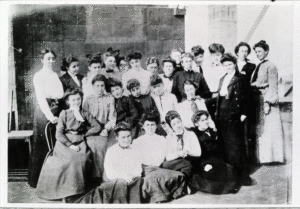
Researchers have found letters detailing Clara Driscoll’s time at Tiffany Studios in New York, shedding light on her “Tiffany Girls” as the Women’s Glass Cutting Department. (Images courtesy DeeDee Wood)
(Editor’s note: DeeDee Wood is the store manager at Tharpe Antiques, in Easton, part of the Talbot Historical Society.)
Clara Driscoll designed most of Louis Comfort Tiffany’s famous lampshades, including the Dragonfly, Wisteria and others.
She worked for Louis Comfort Tiffany from 1887 to 1909 and also designed, anonymously, many mosaics, small desk objects and windows.
Researchers have found letters detailing her time at Tiffany Studios in New York, shedding light on her “Tiffany Girls” as the Women’s Glass Cutting Department was called, as well as her personal feelings and aspirations as a “New Woman” in a turbulent time of change for women in our country.
Clara was born in Ohio in 1861. She lost her father at a very young age and was encouraged to attend a higher learning school, unusual for women for the time period of the late 1800s.
She attended the Western Reserve School of Design for Women and worked locally as a furniture designer before moving to New York and enrolling in the Metropolitan Museum Art School.
Her potential must have been obvious, and she was hired by Tiffany Studios in 1888. Clara was paid $10,000 a year, one of the best salaries a woman could make in New York City in the late 1800s.
Tiffany formed the Women’s Glass Cutting Department in a direct response to a strike by male-only Lead Glaziers and Glass Cutters Union. Tiffany believed, as others did, that women were better suited than men for small hand work and keen decorative taste. He would hire young women right out of art school and with artistic backgrounds for his work. Driscoll checked all of the boxes and was put in charge of the department.
Louis Comfort Tiffany did not allow married women to work for him at Tiffany Studios.
Driscoll left on three different occasions due to marriage and death of spouses, but always returned to Tiffany when things did not work out in her romantic life and she became single again. Driscoll managed the Women’s Glass Cutting Department in Tiffany Studios in New York.
The women, including Driscoll, made patterns from their original designs and selected and cut glass to be used in famous lamps, windows, mosaics and small designer products.
Tiffany employees were segregated by gender, a common workplace practice for the late 1800s.
Women worked in one location, the men in another.
The hierarchy of the department was composed of designers, selectors, assistants and project leaders who would work on sketches, mosaics and landscapes.
Rights were earned and positions worked for in the studios of Tiffany, and the women worked hard.
Until recent letters that Driscoll had written to her mother and sisters were discovered, historians believed that Louis Comfort Tiffany had designed all of his products.
The letters told researchers and historians that Ms. Driscoll had designed some of the most famous pieces Tiffany Studios ever made, including the Wisteria, Dragonfly, Peony lamps, and her first, the Daffodil.
Some of these lamps fetch more than $500,000 in modern auctions around the world, and thanks to her letters and documentation, the Tiffany Girls and Clara Dirscoll are finally getting deserved credit for their creations and hard work.
The turn of the century brought about change on many frontiers, and the working woman in New York City was a change as well.
This was the age of the “New Woman,” promoted by ideas of early Women’s Rights Movement leaders such as Elizabeth Cady Stanton and Susan B. Anthony, women were working and breaking ground in new arenas of employment never thought of before, especially in the big cities.
Many women, including Clara Driscoll, even learned to ride a bicycle, a bold move for the time.
In 1903 working women were so controversial, and biased opinions about women workers were still so prevalent in the workplace, that the men glass workers of Tiffany Glass threatened to strike for a time, finally compromising after demanding that the women be entirely eliminated from the business.
The Women’s Department of Glass had to be capped at 27 workers, never to grow again.
Feeling threatened and territorial over choice projects motivated the threat to strike, but the women remained in employment at the firm.
Clara’s department of women cutting glass included women from all walks of life. Fondly referred to as the “Tiffany Girls,” their skills required careful cutting, copper-foiling, assembly of often thousands of pieces at a time, and many intricately outlined schematics for large products, such as huge paneled windows.
The size of the department varied from the original six to sometimes 35 women. There was Theresa Baur from Brooklyn, and Beatrix Hawthorne, the granddaughter of Nathaniel Hawthorne, Minnie Henderson, Carrie McNicholl, an immigrant from Ireland named Mary McVickar, and a designer named Agnes Northrop that stayed with Tiffany until he closed his doors in the 30s, just to name a few.
From out of the shadows of the past credit is finally being given to Clara Driscoll and her all-female group of working glass cutters.
They were New Yorkers, immigrants, life-long employees and fiercely loyal to Tiffany and each other.
Much like the mosaics in which they created, we are just now seeing the pieces of their lives and their place in Art History being appreciated and discovered.



